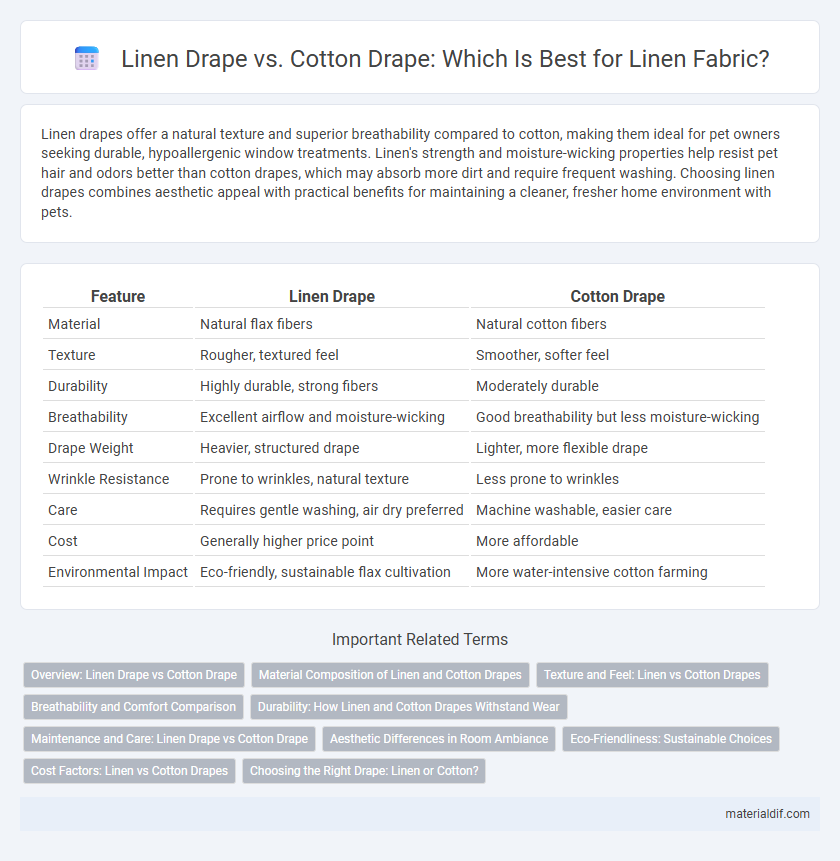Linen drapes offer a natural texture and superior breathability compared to cotton, making them ideal for pet owners seeking durable, hypoallergenic window treatments. Linen's strength and moisture-wicking properties help resist pet hair and odors better than cotton drapes, which may absorb more dirt and require frequent washing. Choosing linen drapes combines aesthetic appeal with practical benefits for maintaining a cleaner, fresher home environment with pets.
Table of Comparison
| Feature | Linen Drape | Cotton Drape |
|---|---|---|
| Material | Natural flax fibers | Natural cotton fibers |
| Texture | Rougher, textured feel | Smoother, softer feel |
| Durability | Highly durable, strong fibers | Moderately durable |
| Breathability | Excellent airflow and moisture-wicking | Good breathability but less moisture-wicking |
| Drape Weight | Heavier, structured drape | Lighter, more flexible drape |
| Wrinkle Resistance | Prone to wrinkles, natural texture | Less prone to wrinkles |
| Care | Requires gentle washing, air dry preferred | Machine washable, easier care |
| Cost | Generally higher price point | More affordable |
| Environmental Impact | Eco-friendly, sustainable flax cultivation | More water-intensive cotton farming |
Overview: Linen Drape vs Cotton Drape
Linen drape offers a crisp, structured silhouette with natural breathability and moisture-wicking properties, making it ideal for warm climates. Cotton drape tends to be softer and more flexible, providing a relaxed fit that adapts easily to body movement. Both fabrics vary in weight and texture, influencing how each garment hangs and responds to wear.
Material Composition of Linen and Cotton Drapes
Linen drapes are crafted from flax fibers, offering superior breathability and durability compared to cotton, which is derived from soft, fluffy seed hairs of the cotton plant. The natural moisture-wicking properties of linen make it ideal for regulating temperature, while cotton drapes provide a softer feel but tend to absorb more moisture, leading to quicker wear. Linen's high tensile strength and resistance to pilling ensure longer-lasting drapes with a slightly textured, crisp aesthetic, contrasting with the smoother, more flexible texture of cotton.
Texture and Feel: Linen vs Cotton Drapes
Linen drapes offer a natural, textured feel with a slightly rougher surface that softens over time, creating a breathable and moisture-wicking fabric ideal for warm climates. Cotton drapes provide a smoother, softer texture from the start, delivering a cozy and lightweight feel that is easy to maintain and versatile for various interior styles. The choice between linen and cotton drapes depends on whether you prefer the rustic texture and durability of linen or the gentle softness and affordability of cotton.
Breathability and Comfort Comparison
Linen drapes offer superior breathability compared to cotton drapes due to their natural fiber structure, which promotes better air circulation and moisture-wicking properties. This enhanced ventilation makes linen ideal for warmer climates, providing a cooler and more comfortable indoor environment. Cotton drapes, while soft and durable, tend to retain more heat and moisture, making them less breathable and slightly less comfortable in hot, humid conditions.
Durability: How Linen and Cotton Drapes Withstand Wear
Linen drapes exhibit superior durability compared to cotton drapes, thanks to their long, strong flax fibers that resist wear and tear over time. Cotton drapes, while soft and breathable, tend to show signs of fraying and fading faster due to shorter staple fibers. High-quality linen maintains structural integrity and color vibrancy through frequent use and washing, making it a preferred choice for long-lasting window treatments.
Maintenance and Care: Linen Drape vs Cotton Drape
Linen drapes require gentle care, often needing hand washing or delicate machine cycles and air drying to maintain their natural texture and prevent shrinkage, while cotton drapes are generally more durable, tolerating regular machine washes and higher heat drying without significant damage. Linen's natural fibers are prone to wrinkles and may need frequent ironing to retain a crisp appearance, whereas cotton drapes exhibit moderate wrinkle resistance and typically require less maintenance. Both materials benefit from regular dusting, but linen drapes may need more careful handling to prolong their lifespan compared to the more resilient cotton options.
Aesthetic Differences in Room Ambiance
Linen drapes create a natural, textured aesthetic that adds an airy, elegant feel to any room, with a slight sheerness allowing soft, diffused light to enhance the ambiance. Cotton drapes offer a smooth finish and a denser weave, providing a more uniform and polished appearance that effectively blocks light for a cozier, more intimate environment. The choice between linen and cotton drapes significantly influences the room's atmosphere by balancing light filtration, texture, and visual warmth.
Eco-Friendliness: Sustainable Choices
Linen drape offers superior eco-friendliness compared to cotton drape due to its natural biodegradability and minimal water usage during cultivation. Flax plants used for linen require fewer pesticides and less energy-intensive processing than cotton, making linen a more sustainable textile choice. Choosing linen drapes supports environmentally responsible home decor through reduced carbon footprint and increased durability.
Cost Factors: Linen vs Cotton Drapes
Linen drapes typically cost more than cotton drapes due to the labor-intensive harvesting and processing of flax fibers, which results in a premium quality fabric with enhanced durability and natural breathability. Cotton drapes are generally more affordable, benefiting from widespread availability and efficient manufacturing processes, making them a popular choice for budget-conscious consumers. The higher price of linen reflects its longevity and unique texture, which can justify the initial investment compared to the lower upfront cost of cotton.
Choosing the Right Drape: Linen or Cotton?
Linen drapes offer superior breathability and a natural texture, making them ideal for warm climates and a relaxed aesthetic, while cotton drapes provide a softer feel and greater versatility in patterns and colors, suited for various interior styles. Choosing linen ensures durability and moisture-wicking properties, whereas cotton is easier to maintain and often more budget-friendly. Consider the room's humidity, desired texture, and maintenance preferences when selecting between linen and cotton drapes for optimal comfort and design impact.
Linen Drape vs Cotton Drape Infographic

 materialdif.com
materialdif.com